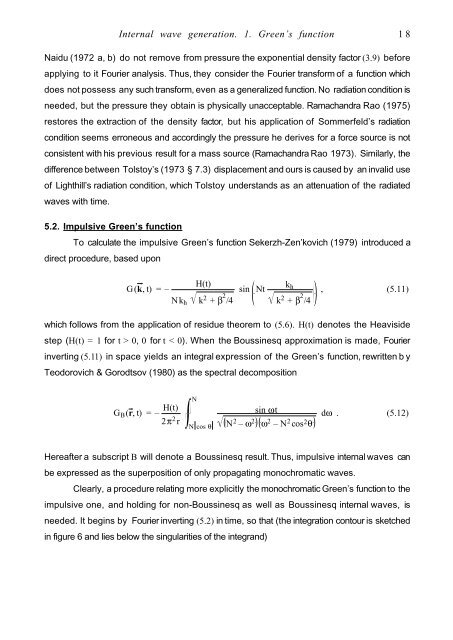Internal Wave Generation in Uniformly Stratified Fluids. 1 ... - LEGI
Internal Wave Generation in Uniformly Stratified Fluids. 1 ... - LEGI
Internal Wave Generation in Uniformly Stratified Fluids. 1 ... - LEGI
You also want an ePaper? Increase the reach of your titles
YUMPU automatically turns print PDFs into web optimized ePapers that Google loves.
Naidu (1972 a, b) do not remove from pressure the exponential density factor (3.9) before<br />
apply<strong>in</strong>g to it Fourier analysis. Thus, they consider the Fourier transform of a function which<br />
does not possess any such transform, even as a generalized function. No radiation condition is<br />
needed, but the pressure they obta<strong>in</strong> is physically unacceptable. Ramachandra Rao (1975)<br />
restores the extraction of the density factor, but his application of Sommerfeld’s radiation<br />
condition seems erroneous and accord<strong>in</strong>gly the pressure he derives for a force source is not<br />
consistent with his previous result for a mass source (Ramachandra Rao 1973). Similarly, the<br />
difference between Tolstoy’s (1973 § 7.3) displacement and ours is caused by an <strong>in</strong>valid use<br />
of Lighthill’s radiation condition, which Tolstoy understands as an attenuation of the radiated<br />
waves with time.<br />
5.2. Impulsive Green’s function<br />
To calculate the impulsive Green’s function Sekerzh-Zen’kovich (1979) <strong>in</strong>troduced a<br />
direct procedure, based upon<br />
<strong>Internal</strong> wave generation. 1. Green’s function 18<br />
G(k, t) = –<br />
H(t)<br />
Nkh k 2 + β 2 /4<br />
s<strong>in</strong> Nt<br />
kh<br />
k 2 + β 2 /4<br />
, (5.11)<br />
which follows from the application of residue theorem to (5.6). H(t) denotes the Heaviside<br />
step (H(t) = 1 for t > 0, 0 for t < 0). When the Bouss<strong>in</strong>esq approximation is made, Fourier<br />
<strong>in</strong>vert<strong>in</strong>g (5.11) <strong>in</strong> space yields an <strong>in</strong>tegral expression of the Green’s function, rewritten by<br />
Teodorovich & Gorodtsov (1980) as the spectral decomposition<br />
GB(r, t) = – H(t)<br />
2π 2 r<br />
N<br />
N cos θ<br />
s<strong>in</strong> ωt<br />
N 2 – ω 2 ω 2 – N 2 cos 2 θ<br />
dω<br />
. (5.12)<br />
Hereafter a subscript B will denote a Bouss<strong>in</strong>esq result. Thus, impulsive <strong>in</strong>ternal waves can<br />
be expressed as the superposition of only propagat<strong>in</strong>g monochromatic waves.<br />
Clearly, a procedure relat<strong>in</strong>g more explicitly the monochromatic Green’s function to the<br />
impulsive one, and hold<strong>in</strong>g for non-Bouss<strong>in</strong>esq as well as Bouss<strong>in</strong>esq <strong>in</strong>ternal waves, is<br />
needed. It beg<strong>in</strong>s by Fourier <strong>in</strong>vert<strong>in</strong>g (5.2) <strong>in</strong> time, so that (the <strong>in</strong>tegration contour is sketched<br />
<strong>in</strong> figure 6 and lies below the s<strong>in</strong>gularities of the <strong>in</strong>tegrand)


